-
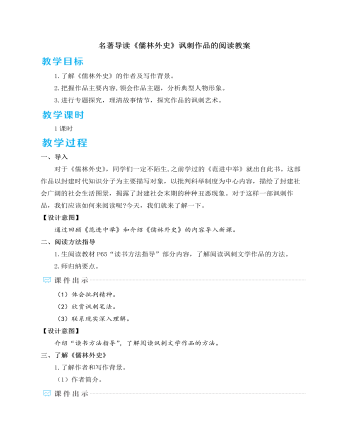
人教部编版语文九年级下册名著导读《儒林外史》讽刺作品的阅读教案
“拱一拱手,一屁股就坐在上席”,两个动作活画出了夏总甲在乡民面前的傲慢自大。作者接着写他的一番话语:“俺如今倒不如你们务农的快活了。想这新年大节,老爷衙门里,三班六房,那一位不送帖子来。我怎好不去贺节?每日骑着这个驴,上县下乡,跑得昏头晕脑。”“从新年这七八日,何曾得一个闲?恨不得长出两张嘴来,还吃不退。”巧妙地揭示了他为何目中无人和衣服“就如酒篓一般”。二、通过故事情节的前后对比来表达讽刺。第二回中,周进六十多岁了,还以老童生的身份在薛家集观音庵教私塾,一年才十二两馆银,生活窘困,地位低下,村中新中秀才青年梅玖也奚落他。到第七回中,周进中了进士,做了官以后,梅玖就无耻地冒充自己是周进的学生,薛家集的观音庵里也供起了周进的长生牌位。梅玖见了周进早年写的一副对联,贴在墙上,红纸都发白了,竟吩咐和尚用水喷了,剥下来装裱收藏。这一对比既写出了周进做官前后迥然不同的境遇,也写出了秀才梅玖的庸俗势利以及社会上一些人的趋炎附势。所以,《儒林外史》的讽刺,不仅仅是对人物的讽刺,更是对当时社会中各种现象的揭露、控诉和批判。
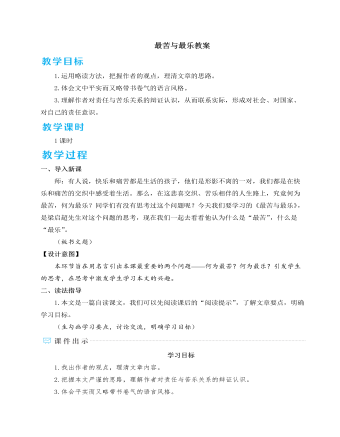
人教部编版七年级下册最苦与最乐教案
梁启超(1873—1929),字卓如,号任公,别号饮冰室主人。广东新会人,思想家、学者。清朝光绪年间举人,戊戌变法(百日维新)领袖之一、中国近代维新派、新法家代表人物。幼年受传统教育,光绪十年(1884)中秀才,1889年中举。后从师于康有为,成为资产阶级改良派的宣传家。维新变法前,协助康有为一起联合在京应试举人发动“公车上书”运动,此后先后领导北京和上海的强学会,又与黄遵宪一起办《时务报》,任长沙时务学堂的总教习,并著《变法通议》为变法做宣传。戊戌变法失败后,逃亡日本。晚年任清华国学研究院导师。他一生著述颇丰,著有《清代学术概论》《中国近三百年学术史》等,著作大多收入《饮冰室合集》。文学知识议论文议论文是一种以议论为主要表达方式,通过摆事实、讲道理,直接表达作者的观点和主张的常用文体。论点、论据和论证,是议论文的三要素。

人教部编版语文八年级上册一着惊海天—目击我国航母舰载战斗机首架次成功着舰教案
2012年9月25日被称作辽宁舰的中国航母,是在苏联时期乌克兰黑海造船厂建造的“库兹涅佐夫元帅级”航空母舰次舰“瓦良格”号的基础上续建的。1991年12月苏联解体时,该航母已完工约70%,后来由于种种原因,俄罗斯海军取消了订单,这艘即将完工的航母被迫停产,随之报废。1998年4月,澳门创律旅游娱乐公司通过竞标,以2000万美元买下几乎拆成空壳子的“瓦良格”号航母。2005年4月“瓦良格”进入大连造船厂,由政府接管。此时的“瓦良格”只是一个锈迹斑斑的钢铁空壳,所有武器、电子系统均已被拆除或者破坏。中国海军准备在“瓦良格”的原型上进行续建,俄罗斯却不肯出让阻拦索技术,中国只能自行研制。所以,辽宁舰的改造经历了怎样的艰难历程,漫长的科技攻关之路遇到的重重障碍就可想而知了。疑难突破作为一篇新闻作品,本文是如何打动读者的?通过反复渲染、蓄势,营造训练现场的氛围,让读者透过文字感受从期待到紧张到彻底释放的心理过程,从而受到情感上的冲击。
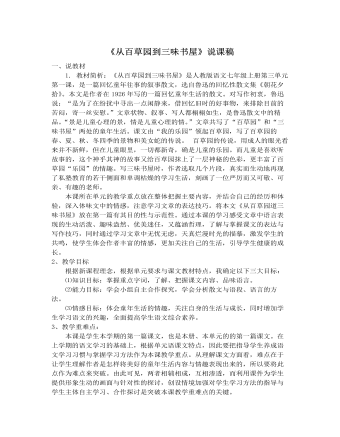
部编版语文七年级上册《从百草园到三味书屋》说课稿
2、教学目标根据新课程理念,根据单元要求与课文教材特点,我确定以下三大目标:⑴知识目标:掌握重点字词,了解、把握课文内容、品味语言。⑵能力目标:学会小组自主合作探究,学会分析散文与语段、语言的方法。⑶情感目标:体会童年生活的情趣,关注自身的生活与成长,同时增加学生学习语文的兴趣,全面提高学生语文综合素养。3、教学重难点:本课是学生本学期的第一篇课文,也是本册、本单元的的第一篇课文。在上学期的语文学习的基础上,根据单元语课文特点,因此要把指导学生养成语文学习习惯与掌握学习方法作为本课教学重点。从理解课文方面看,难点在于让学生理解作者是怎样将美好的童年生活内容与情趣表现出来的,所以要将此点作为难点来突破。由此可见,两者相辅相成,互相渗透,而利用课件为学生提供形象生动的画面与针对性的探讨,创设情境加强对学生学习方法的指导与学生主体自主学习、合作探讨是突破本课教学重难点的关键。
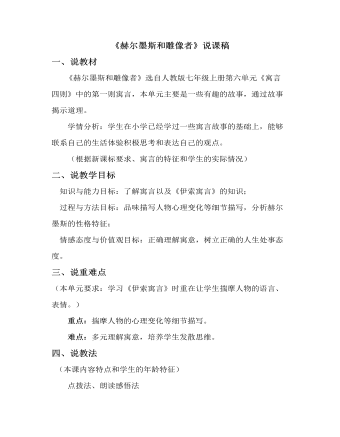
部编版语文七年级上册《赫尔墨斯和雕像者》说课稿
一、说教材《赫尔墨斯和雕像者》选自人教版七年级上册第六单元《寓言四则》中的第一则寓言,本单元主要是一些有趣的故事,通过故事揭示道理。学情分析:学生在小学已经学过一些寓言故事的基础上,能够联系自己的生活体验积极思考和表达自己的观点。(根据新课标要求、寓言的特征和学生的实际情况)二、说教学目标知识与能力目标:了解寓言以及《伊索寓言》的知识;过程与方法目标:品味描写人物心理变化等细节描写,分析赫尔墨斯的性格特征;情感态度与价值观目标:正确理解寓意,树立正确的人生处事态度。三、说重难点(本单元要求:学习《伊索寓言》时重在让学生揣摩人物的语言、表情。)重点:揣摩人物的心理变化等细节描写。难点:多元理解寓意,培养学生发散思维。
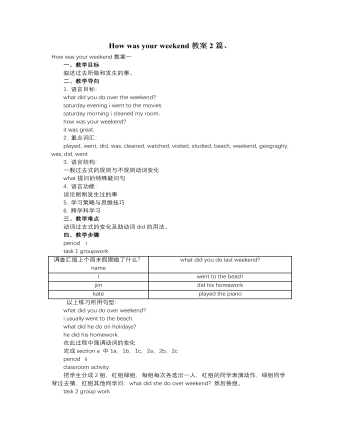
人教版新目标初中英语七年级下册How was your weekend教案2篇
Teaching Goal:1. General aims:Talk about recent past events2. Particular aims:A. Language Focus.Talk about recent past events and think of the past events.B. Language goalsHow was….?It was …What did …do over the weekend?C. Language structures:(1). How was your weekend? I was great. Pay attention to no form.(2). What did you do over the weekend? I played soccer. We went to the beach.D. Useful words and phrases:Words: was, did, went, beach, over, project, test, wasn’t, false, number, geography, spend, week, most, mixture, their, had, little, cook, read, saw, change, everyone, sit, sat, no, anythingPhrases: did one’s homework, played soccer, cleaned my room, went to the beach, played tennis, went to the movies, on Saturday morning, over the weekend, cook … for, what about, do some reading, have a party, talk show, go shoppingE. Grammar language:Present simple past tenseRegular and irregular verbsF. Learning strategies:Tour and holidaysG. Interdiscipinary:H. Emotion and manner:Teaching time: 5 periodsTeaching procedures:Period One教学步骤、时间 教师活动 学生活动 媒体应用Step 1Free talk 3’ Ask some questions like:Who’s on duty today?What’s the weather like? Answer and talk about something.让同学们回答下列问题1. Do you like weekend? (Let some students answer)It takes them three minutes to talk about the question.2. Why do you like weekend? (let the students answer) Most of the students like the weekend此时教师用汉语问:“在周末期间问你干了什么?这句话用英语这么回答?Let the students guess.At last the teacher give them right answer3. What did you do over the weekend?(板书、学习)
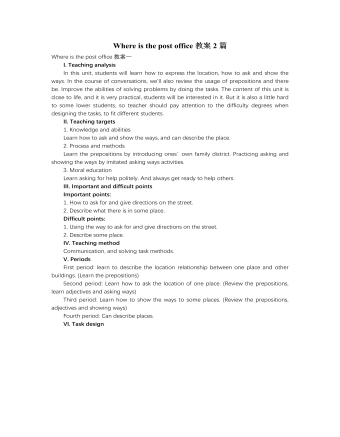
人教版新目标初中英语七年级下册Where is the post office教案2篇
Period 2 (3a----Section B 2c)Preview(Pre-task): Key points: What laAdd another information about their pen pals----their language on the cardnguage does she/he speak?She/He speaks....Does she/he have any brothers and sisters? Does she/he speak English?Preview(Pre-task): Add another information about their pen pals----their language on the cardKey points: What language does she/he speak?She/He speaks....Does she/he have any brothers and sisters? Does she/he speak English?Step 1 Revision1.Revisionand dictation of the new words 2.Revise the drills they learned yesterday.(by pairwork and grammar exercise)Step 2 Leading-inT has a conversation with one student. The conversation is following:---Do you have a pen pal?---Yes, I do.---What's your pen pal's name? ---His/Her name is....---Where is your pen pal from? ---He/She is from...---Where does he/she live? ---He/She lives in....---What language does he/she speak?He/She speaks...Write the new words on the Bb. They are following: EnglishChineseJapaneseFrenchStep 3 LearnLearn the new words with the whole class.Finish 3a with the students3b Pairwork T still does an example with one student Then the Ss practise in pairs. The example is following:--Curry Muray is my pen pal. He is from the United States.---What language does he speak?

人教版新目标初中英语七年级下册Don’t eat in class教案2篇
Don’t fight. =You can’t fight. (板书,教读)教师把这些句子板书在黑板上,并请学生大声整齐地读祈使句和“can’t”句型,并让学生注意两种句型表达形式的不同和转换,“Don’t …=You can’t…”;并对学生说:These are our school rules. (板书,教读) You can’t break the school rules. Don’t break the school rules.(板书,教读)步骤3 :Practicea. T: Now, each of the students is breaking one of these rules.Please finish 1a.学生看图,完成1a的内容,检查答案并大声朗读校规。b. 听录音,完成1b,选出四位学生都违反了哪条校规;听之前,学生要读会英文名。c. 请两位学生朗读1c部分的句型;要求学生两人一组对话表演,SA扮演外校转来新生,SB告知本校校规。(学生可经过讨论,多说出他们想到的校规,不必只限于书上;教师应给予帮助)2) 第二课时(2a~4)步骤1 :warming up of revisionT: What are the rules at your school?学生使用“can”或祈使句表达各条校规;其中老师可引出“eat in the cafeteria outside”的表达。步骤2 :Practicea.T: Christina is an exchange student. She doesn’t know the rules. Let’s listen, what activities they’re talking about?学生听第一遍时,完成2a;第二遍时,完成2b;b. 请学生领读2c部分,看着2a完成的表格,理解2c活动的要求;分成小组针对2a进行问答;
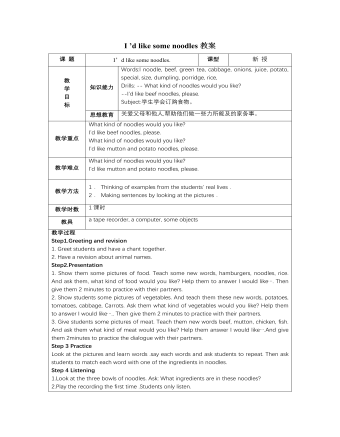
人教版新目标初中英语七年级下册I ’d like some noodles教案
教学过程Step 1: warming-up Sing a song---------“food and drink” Step 2: Revision1 Dictation2 Revise: What kind of noodles would you like?I’d like …What size bowl of noodles would you like?I’d like…Step 3: Presentation1 show pictures of food, ask students say the words.2 Students read the newspaper ad in 3a. Fill in blanks with words in the box. Then read the ad together, the teacher explains some difficult language points.3 Check the answers Step 4 PracticeAsk students to finish 3b in the same way according to 3a. Students read the short passage and fill in the blanks .At last, check the answers.Step 5 productionAsk students to write their own ad for dumplings, noodles, drinks, and other foods they know. Then ask students to read their partner’s ad. Then order food and drink from their partner.Step 6 Home workGroup work – make an ad about “food and drink”
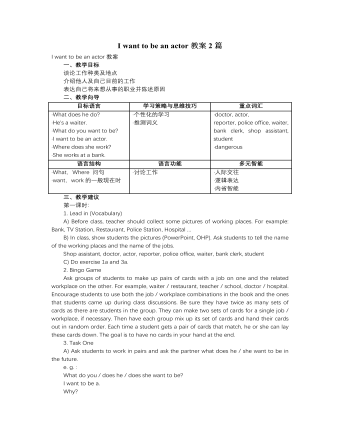
人教版新目标初中英语七年级下册I want to be an actor教案2篇
三、教学建议第一课时:1. Lead in (Vocabulary)A) Before class, teacher should collect some pictures of working places. For example: Bank, TV Station, Restaurant, Police Station, Hospital ...B) In class, show students the pictures (PowerPoint, OHP). Ask students to tell the name of the working places and the name of the jobs.Shop assistant, doctor, actor, reporter, police office, waiter, bank clerk, studentC) Do exercise 1a and 3a.2. Bingo GameAsk groups of students to make up pairs of cards with a job on one and the related workplace on the other. For example, waiter / restaurant, teacher / school, doctor / hospital. Encourage students to use both the job / workplace combinations in the book and the ones that students came up during class discussions. Be sure they have twice as many sets of cards as there are students in the group. They can make two sets of cards for a single job / workplace, if necessary. Then have each group mix up its set of cards and hand their cards out in random order. Each time a student gets a pair of cards that match, he or she can lay these cards down. The goal is to have no cards in your hand at the end.3. Task OneA) Ask students to work in pairs and ask the partner what does he / she want to be in the future.e. g. :What do you / does he / does she want to be?I want to be a.Why?Because it's (adj).B) Vocabulary: Section B, 1a4. Homework 1.2.
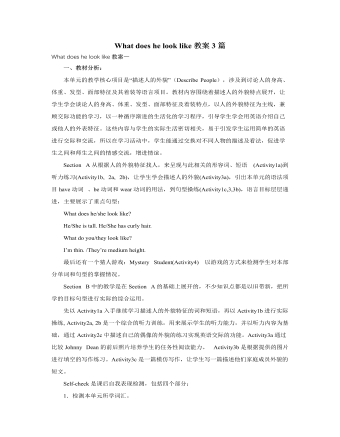
人教版新目标初中英语七年级下册What does he look like教案3篇
所需要用到的句子:Who is that?That is Jack. I like him.Why do you like him?I like him because he is interesting.Task 4: 设计理想中的人类Step one: 设计理想中的人类的外貌。把全班同学分成若干小组,学生可以边说边在纸上画出他们的模样。Step two: 设计理想中人类的性格。学生们可以把那些能描述性格的单词写在图画的旁边。Step three: 每组选出一名同学,其他同组同学提问,他作简单回答,并说明原因。所需用到的句子:What does he or she look like?He or she ...What is he or she like?He or she is ...Why?Because ...Task 5: 挑战性活动调查性格是天生的还是后天形成的,让每个同学回家去调查一下自己成长过程中性格是否有变化,具体是怎样的,为什么会这样? Teaching Aims:1. Enable students to have a general understanding of how to talk about people's physical appearance.2. Enable students to tackle some essential vocabularies and patterns about describing people. Provide them with necessary skills and methods.3. Create various chances for students to describe the persons they're familiar with, such as classmates, family members, teachers, idols, etc.
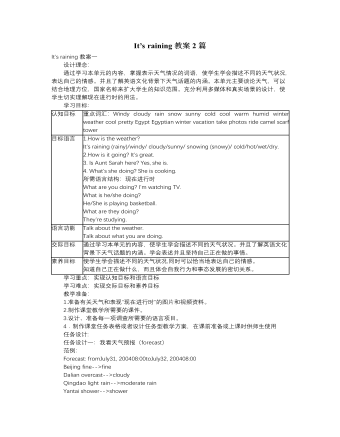
人教版新目标初中英语七年级下册It’s raining教案2篇
1 Each group choose one place to describe and what you are doing in it Choose one place, and describe what they are doing 2 Move around the room and give suggestions Talk about it and write it down 3 Ask one to show their works and act it Choose one of each group to make a report 4 Evaluate the best group and the best reporter Choose the best one Homework Ask your friends their ideal place and write about it教学反思:新课程标准中强调学生在课堂中的主体地位,在综合课中他们的主体地位就更加突出。在各个活动中给不同程度的学生不同层次的任务,让各层面的学生都有表现发挥的机会,从而产生对英语的兴趣。使用照片图片多媒体来辅助教学,效果更好。同时让了解其他国家风景,风俗的同学介绍ideal place,增加学生的背景知知识,实现跨学科交流的目的。教案点评:采用任务型教学模式,在各个活动中给不同程度的学生不同层次的任务,让各层面的学生都有表现发挥的机会,从而产生对英语的兴趣。使用照片图片多媒体来辅助教学,效果更好。让了解其他国家风景,风俗的同学介绍ideal place,增加学生的背景知识,实现跨学科交流的目的。
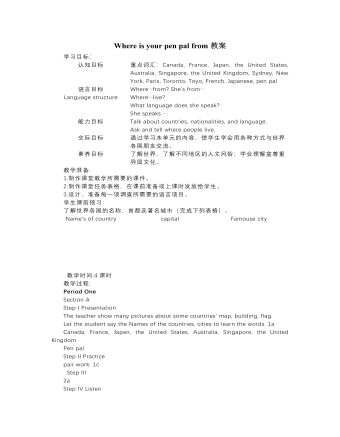
人教版新目标初中英语七年级下册Where is your pen pal from教案
2.1Match the country with the language.Step II Reading3a? let the students read the letter fast and answer the questions.? Let the students ask more questions about the letter as possible as the can.Step III Writing3b.Step IV. Pairwork2cStep V Listening2a, 2bStep V. HomeworkExercises book(1) P3Exercises book (2) P3Period FourStep I . Dictate the words and sentences in Unit1.Step II. Self-checkStep III. Check the answers for Exercises book in the unit.Step IV. Home workRevise and preparation for unit 2.教学反思:通过本单元的学习,学生基本可以谈论人们的国籍,居住城市及其所说的语言,通过书信方式去介绍自己并寻找笔友。但在涉及到国外的一些城市时,学生对这方面的知识相对欠缺,能介绍的城市并不多,也反应出学生课前预习不充分,这跟学生学习条件也有关,大多数学生无法通过网络获取所需信息。因此,在以后的教学中要多指导学生通过计算机网络获取信息,拓宽知识面。
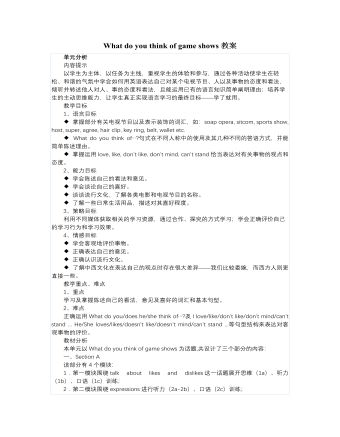
人教版新目标初中英语七年级下册What do you think of game shows教案
五、教学Section B-2c1. Pair work: What do you think of the belt/sunglasses/…? What does your father/mother/… think of your scarf/belt…?2. Group work(1). Teacher shows some different kinds of school uniforms (制服)and asks : “ What do you think of your school uniforms? If you have a chance to choose your school uniforms, what kind would you like to choose?”(2). Discuss in groups.(3).Get some Ss to report in class.说明:这一步旨在让学生运用已有的语言知识谈论对事物的看法和意见,并简单阐明理由,培养学生的主动思维能力和运用英语的能力。六、教学拓展调查电视节目的收视率任务:调查你周围的人对现在各种电视节目的反响。活动过程:1.教师布置任务,让学生调查周围的人(包括他的亲戚朋友和邻居)喜欢收看哪方面的电视节目。2.学生进行调查活动,运用本单元所学的句型What do you think of….? (Why?)What's your favorite game shows?What do you think of talk show?I doesn’t mind it.I like it.I love it.I can’t stand it.3.记录下排在前10位的TV Program,填写调查表,比较其收视率。

人教版新目标初中英语七年级下册Where did you go on vacation教案
句型: Where did you go on vacation? I went to summer camp.Did she go to Central Park?Yes,she did.No, she didn’t语法:一般过去时特殊疑问句、一般疑问句及肯、否定回答。课时安排4课时第一课时:Section A:la,1b,lc,2a,2b,2c 第二课时:Section A:3a,3b,4第三课时:Section B:1,2a,2b,2c第四课时:Section B:3a,3b,3c,4 and Self Check第一课时教学目标掌握描写假期生活的形容词。假期里自己所做事情的简单表达。谈论假期做的事情及当时情况。谈论假期时旅游的天气,旅游者以及食物等。教学过程一、导入播放一首英文歌曲:Let’s travel 说明:通过让学生听节奏欢快迪斯尼英语歌曲Let’s travel.引入本节课谈论的话题vacation and travel. 让歌曲使学生的思维活跃,增强课堂气氛,激发学生提高学习英语的兴趣。T:How is the trip ?Ss : It’s pretty good/ happy/exciting /relaxing/busy/dangerous/ fantastic说明:这个问题是为了操练形容词。建议让多个Ss作答。鼓励他们用不同的形容词。上述个别形容词本应在第二课时中出现,但可以在warming-up中第一次非正式出现。这些形容词也可在老师的评价语中适时出现,以加深学生对词汇的印象。
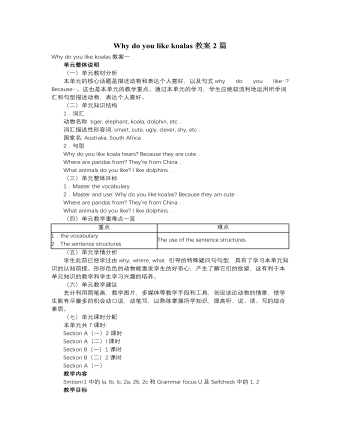
人教版新目标初中英语七年级下册Why do you like koalas教案2篇
单元整体说明(一)单元教材分析本单元的核心话题是描述动物和表达个人喜好,以及句式why do you like…? Because…。这也是本单元的教学重点。通过本单元的学习,学生应能较流利地运用所学词汇和句型描述动物,表达个人喜好。(二)单元知识结构1.词汇动物名称 tiger, elephant, koala, dolphin, etc.词汇描述性形容词: smart, cute, ugly, clever, shy, etc.国家名: Australia, South Africa2.句型Why do you like koala hears? Because they are cute.Where are pandas from? They're from China.What animals do you like? I like dolphins.(三)单元整体目标1.Master the vocabulary2.Master and use: Why do you like koalas? Because they am cute.Where are pandas from? They're from China.What animals do you like? I like dolphins.(四)单元教学重难点一览(五)单元学情分析学生此前已经学过由why, where, what 引导的特殊疑问句句型,具有了学习本单元知识的认知前提。形形色色的动物能激发学生的好奇心,产生了解它们的欲望,这有利于本单元知识的教学和学生学习兴趣的培养。
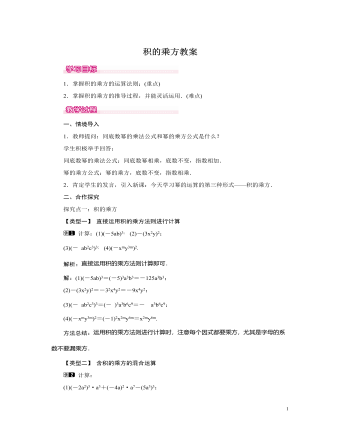
北师大初中七年级数学下册积的乘方教案
【类型一】 逆用积的乘方进行简便运算计算:(23)2014×(32)2015.解析:将(32)2015转化为(32)2014×32,再逆用积的乘方公式进行计算.解:原式=(23)2014×(32)2014×32=(23×32)2014×32=32.方法总结:对公式an·bn=(ab)n要灵活运用,对于不符合公式的形式,要通过恒等变形转化为公式的形式,运用此公式可进行简便运算.【类型二】 逆用积的乘方比较数的大小试比较大小:213×310与210×312.解:∵213×310=23×(2×3)10,210×312=32×(2×3)10,又∵23<32,∴213×310<210×312.方法总结:利用积的乘方,转化成同底数的同指数幂是解答此类问题的关键.三、板书设计1.积的乘方法则:积的乘方等于各因式乘方的积.即(ab)n=anbn(n是正整数).2.积的乘方的运用在本节的教学过程中教师可以采用与前面相同的方式展开教学.教师在讲解积的乘方公式的应用时,再补充讲解积的乘方公式的逆运算:an·bn=(ab)n,同时教师为了提高学生的运算速度和应用能力,也可以补充讲解:当n为奇数时,(-a)n=-an(n为正整数);当n为偶数时,(-a)n=an(n为正整数)
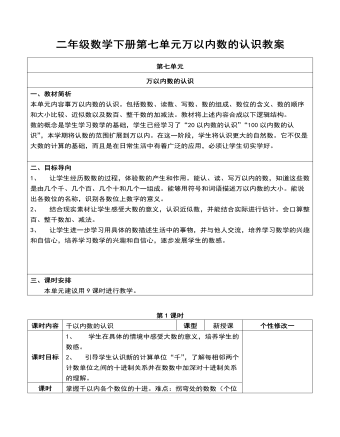
二年级数学下册第七单元万以内数的认识教案
一、复习导入1、口答:最大的一位数是几?最小的两位数是多少?这两个数相差多少?2、数数:10个10个地数,从10数到100; 1个1个地数,从91数到99; 问:99加1是多少?3、导入:你会从100开始接着往后数吗?今天开始我们将要学习更大的数,下面请你们观察这幅图。二、讲授新课1、出示主题图。(1)观察这幅图,说一说画面上正在发生什么事情?(2)看着画面你想知道什么问题?引导学生估算画面上的体育馆大约能坐多少人?2、板书课题:1000以内数的认识。3、教学例1。(1)数一数。每人数出10个小方块,说说你是怎么数的?板书:一个一个地数,10个一是十。
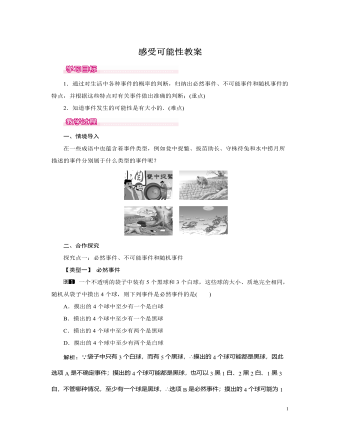
北师大初中七年级数学下册感受可能性教案
一个不透明的袋子中装有5个黑球和3个白球,这些球的大小、质地完全相同,随机从袋子中摸出4个球,则下列事件是必然事件的是( )A.摸出的4个球中至少有一个是白球B.摸出的4个球中至少有一个是黑球C.摸出的4个球中至少有两个是黑球D.摸出的4个球中至少有两个是白球解析:∵袋子中只有3个白球,而有5个黑球,∴摸出的4个球可能都是黑球,因此选项A是不确定事件;摸出的4个球可能都是黑球,也可以3黑1白、2黑2白、1黑3白,不管哪种情况,至少有一个球是黑球,∴选项B是必然事件;摸出的4个球可能为1黑3白,∴选项C是不确定事件;摸出的4个球可能都是黑球或1白3黑,∴选项D是不确定事件.故选B.方法总结:事件类型的判断首先要判断该事件发生与否是不是确定的.若是确定的,再判断其是必然发生的(必然事件),还是必然不发生的(不可能事件).若是不确定的,则该事件是不确定事件.
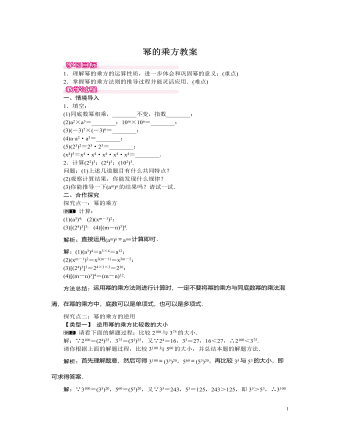
北师大初中七年级数学下册幂的乘方教案
方法总结:本题考查了幂的乘方的逆用及同底数幂的乘法,整体代入求解也比较关键.【类型三】 逆用幂的乘方结合方程思想求值已知221=8y+1,9y=3x-9,则代数式13x+12y的值为________.解析:由221=8y+1,9y=3x-9得221=23(y+1),32y=3x-9,则21=3(y+1),2y=x-9,解得x=21,y=6,故代数式13x+12y=7+3=10.故答案为10.方法总结:根据幂的乘方的逆运算进行转化得到x和y的方程组,求出x、y,再计算代数式.三、板书设计1.幂的乘方法则:幂的乘方,底数不变,指数相乘.即(am)n=amn(m,n都是正整数).2.幂的乘方的运用幂的乘方公式的探究方式和前节类似,因此在教学中可以利用该优势展开教学,在探究过程中可以进一步发挥学生的主动性,尽可能地让学生在已有知识的基础上,通过自主探究,获得幂的乘方运算的感性认识,进而理解运算法则





















